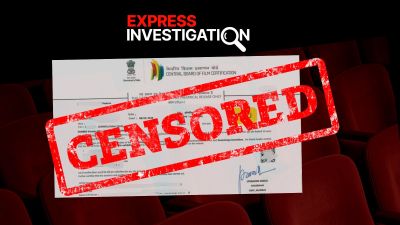Ram Gopal Varma ka private joke
Yet another talentless remake. More evidence that we’ve lost the ability to be inspired by the old to newer and larger ways of seeing

After the rage comes laughter. I sat through Ram Gopal Varma Ki Aag with growing disbelief and distaste, and when I finally reeled out of the hall, I was angry. Angry. Few films make you angry. You watch an incompetent film, you hate it, you move on. This film makes you angry. Because this — this remake or whatever of Sholay — is a monumentally idiotic insult to one of the most iconic films made in India, an insult to everyone who saw it and loved it, and to their memories. What crime can be higher than a boot stamping on your memories?
But I am not going to vent my spleen any more on this disgusting piece of film-making that, in its best moments, plays like a private joke told by a talentless drunk scratching his crotch. Because I need to move on. And the only way I can is to laugh. After the rage…
Remakes are hot in the Hindi film industry now, the camouflage facepaint that tries to hide the reality that the guys who run the business are running out of ideas. I had the good fortune to switch on the TV one night when both the Dons were on, on separate channels. I kept switching between them, and it was quite educational. The most important thing I learnt was that Kareena Kapoor is no Helen, and two hip wiggles from a fully-clothed Zeenat Aman are far sexier than Priyanka Chopra prancing in next to nothing. The rest of what went on and how the two films compared with each other is mere detail, to do with advances in cinema technology over 30 years.
No, I am not going to talk about this joke of a film. Even though just one viewing tells you that Varma understood nothing about why Sholay grabbed that special place in people’s hearts, understood nothing even though he, as he claims, saw it 35 times or more. When you replace that magnificent mountainous terrain with the seedy bylanes of a Mumbai suburb, you scale an epic down to a grimy pirated copy of a self-help book being sold by beggars at traffic lights. And when you have Jai (Raj in this film) beaten and shot dead at point blank range by the Gabbar character, you violate the memory of his mythic death in the original, while fighting off dozens of dacoits and blowing up a bridge to make sure that Veeru and Basanti escape safely. You just haven’t got it, boy, and you won’t, even if you put Sholay on a chip and implant it under your skin.
Sorry, I had promised I wasn’t going to talk about this, this sick travesty that’s playing on a screen in your neighbourhood. I was going to talk about remakes. And even when you do a remake, you can escape the tyranny of mass memory by pretending it’s not one. Sholay has been rehashed many times, and during my misspent youth, I had the opportunity to see two of them. One was Aandhi Toofan, where Sholay’s horses were replaced by motorcycles. The Thakur Baldev Singh character was played by, yes, Hema Malini. Then there’s Paanch Qaidi, with, well, yes, Girish Karnad as the hero, and Amjad Khan on the side of the good guys: quite an enjoyable film, except that whoever made it couldn’t count, since the actual number of qaidis hired to kill the villain is higher than five. But the point is that neither film referenced Sholay officially; the makers were smart enough to figure that one out.
Sholay itself gets its story from The Magnificent Seven, which acknowledges that it is inspired by Akira Kurosawa’s Seven Samurai. Entire sequences in Sholay — like the train dacoity, the killing of Thakur’s family, the final standoff when Jai forces Veeru and Basanti to flee — are lifted from films like Once Upon A Time In The West and The Professionals. But at every step, Sholay used the springboard of the already-done to hit new highs of style and adrenaline. For instance, every sequence that I mentioned is actually filmed much better in Sholay than in the originals. It copies just one five-second shot from Seven Samurai, of dacoits riding their horses as an enormous sun rises behind them, and does it better. There’s a fine line between inspiration and plagiarism, but it’s also not so fine as to be missed by most. When the Battleship Potemkin sequence of a pram rolling down the Odessa Steps is reprised in Grand Central station in Brian de Palma’s The Untouchables, and during a bank robbery scene in N. Chandra’s Tezaab, there’s a difference. Sholay teaches you that difference.
The question is: Why can’t we leave some things alone? Just let them be? Why do we have to have a remake of/ tribute to Sholay, where the Gabbar Singh character plays the mouth organ?
Or, if we do have to remake, why can’t we be Pierre Menard? In Argentine uber-author Jorge Luis Borges’ wildly funny story masquerading as a literary review, a man called Pierre Menard attempts to rewrite Don Quixote. Which he does, punctuation mark by punctuation mark. And the narrator (the reviewer of the few chapters of Quixote that Menard managed to rewrite) finds the “new” work far more affecting than the original. Where a comma put by Cervantes is sterile today, four centuries later, Menard’s comma comes tingling with meaning and subtext.
After seeing this film, I need to re-read Pierre Menard, Author of the Quixote, once more. I need the laughter after the rage.
The writer is editor, ‘The Financial Express’



- 01
- 02
- 03
- 04
- 05




























